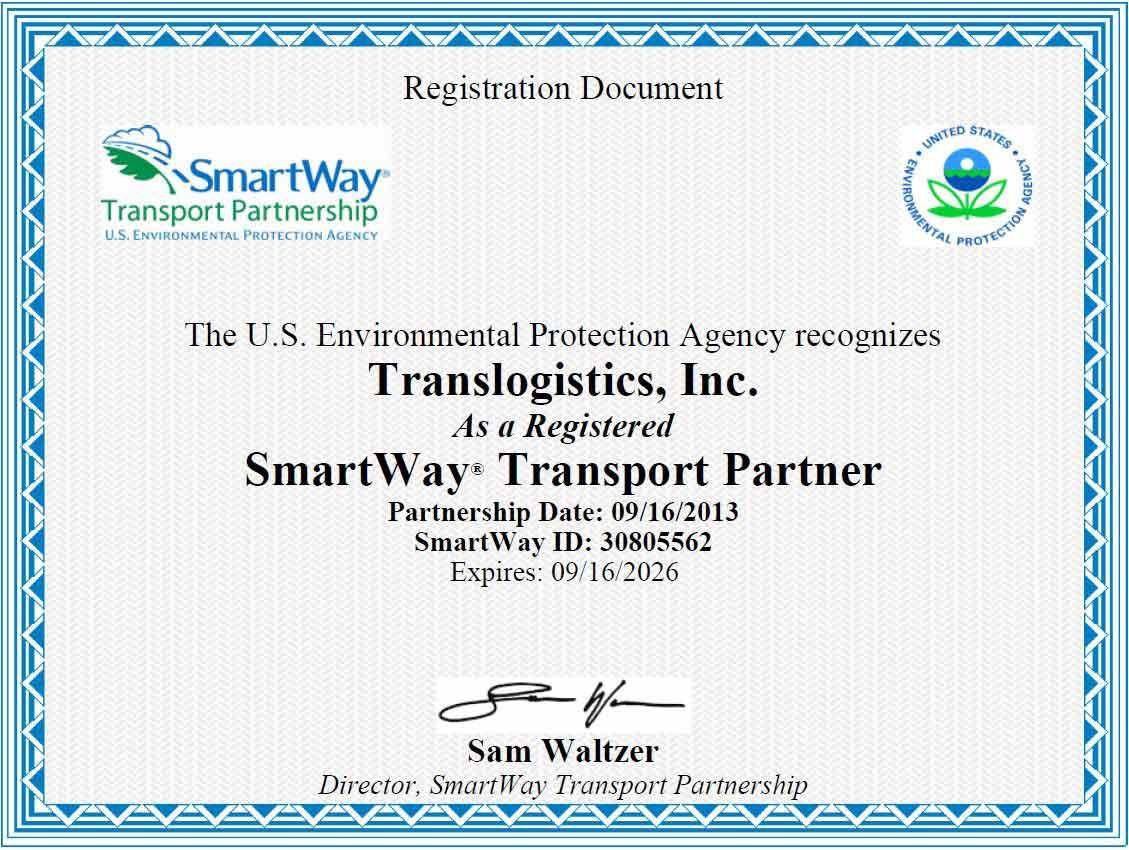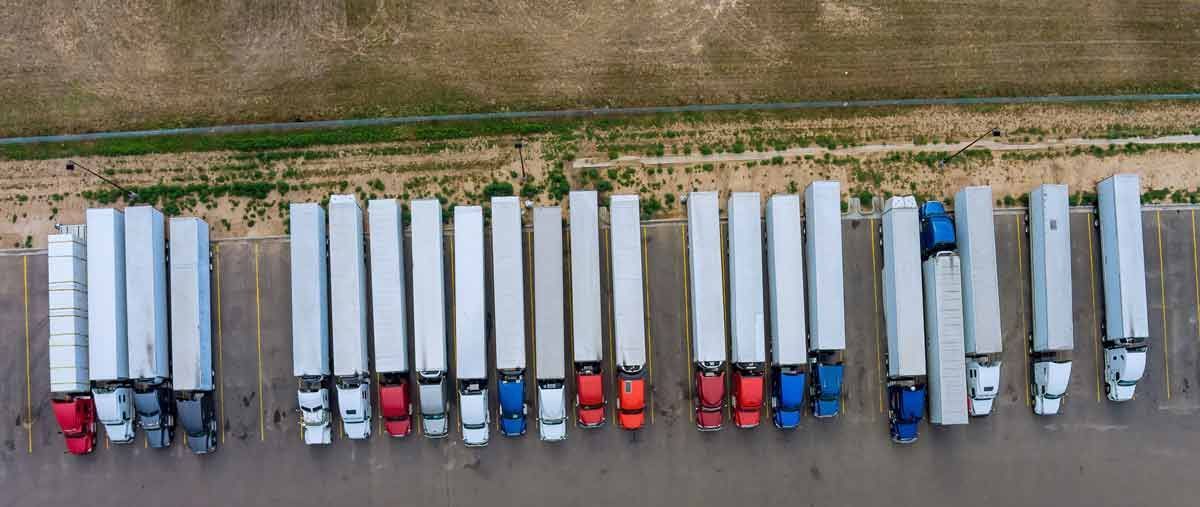Standard Freight Glossary & Supply Chain Definitions
Cargo Shipping Terms
Understanding cargo shipping terms is essential for shippers. These terms help ensure smooth and efficient freight transportation. By educating themselves on these terms, shippers can avoid costly mistakes, ensure compliance, and streamline their shipping processes. This knowledge empowers shippers to communicate effectively with freight brokers, 3PLs, motor carriers, negotiate better shipping rates, and handle documentation accurately.
Many freight bills include confusing terms that can overwhelm shippers. Often, even experienced shippers struggle to determine freight class or NMFC codes, leading to errors and extra costs. This document aims to simplify these concepts. By reading it, shippers will gain clarity on invoice terms, understand how to accurately determine freight class, and use NMFC codes effectively. This knowledge will make their shipping process smoother and more cost-effective.

Shipping Terms
Type 'CRTL + F' to have the search function made available to search for your desired term.
Accessorials
Accessorials in LTL (Less Than Truckload) and FTL (Full Truckload) shipping refer to additional services or fees beyond the standard transportation costs. Carriers charge these extras for tasks that require more time, effort, or specialized equipment. Common accessorials include liftgate service, inside delivery, limited access locations, and residential delivery. Shippers must understand these charges to accurately calculate shipping costs and avoid unexpected expenses.
Proper management of accessorials can significantly impact a company's bottom line. Shippers can reduce costs by clearly communicating their needs to carriers, anticipating potential accessorials, and negotiating rates in advance. Some businesses even adjust their shipping practices or facility layouts to minimize accessorial charges. By mastering the intricacies of accessorials, logistics professionals optimize their shipping strategies and enhance their supply chain efficiency.
Backhaul
Backhaul refers to the trips trucks take back to or near their starting point, often carrying different cargo from their outbound journey to avoid empty mileage.
Billing Adjustment
A billing adjustment covers unpaid freight shipping costs as reported by the motor carrier.
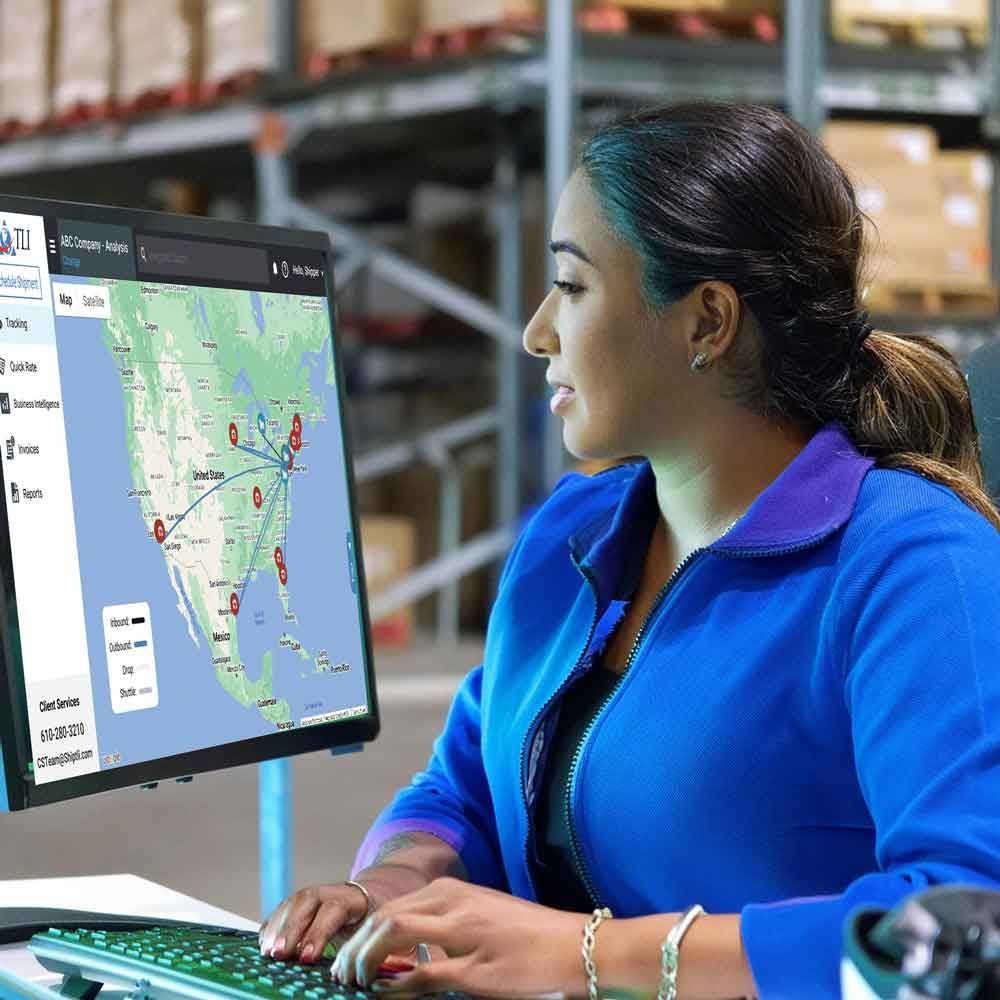
Blanket Wrapped Freight
Blanket Wrapped Freight involves wrapping goods in thick blankets for protection during shipment.
Blind Shipment
A blind shipment in the LTL market refers to a shipping arrangement where the identity of either the shipper or the consignee remains hidden from the other party. This setup maintains confidentiality and protects business relationships, especially in situations involving intermediaries or competitive markets.
In a blind shipment, the carrier plays a crucial role by creating separate bills of lading. One document shows the actual shipper but lists the carrier's terminal as the destination. The other document displays the real consignee but lists the carrier's terminal as the origin. This process effectively "blinds" the shipper from knowing the final destination and the consignee from knowing the original shipper. Logistics professionals use blind shipments to prevent direct contact between manufacturers and end customers, protect pricing information, or maintain anonymity in sensitive shipments.
Cargo Carriers
In the trucking sector, cargo carriers include both LTL and FTL providers. LTL carriers consolidate shipments from multiple shippers into a single truck, optimizing space and reducing costs for smaller loads. FTL carriers, on the other hand, dedicate entire trucks to a single shipper's goods, offering faster transit times and reduced handling. Ocean carriers transport large volumes of goods across seas in container ships, while air cargo carriers provide rapid, global delivery for time-sensitive or high-value items. Rail carriers excel in moving heavy, bulk commodities over long distances. Each type of cargo carrier offers unique advantages, allowing shippers to choose the best option based on their specific needs, timelines, and budgets.
Cargo Companies
Cargo companies provide freight services for commercial and residential shippers.
Cargo Containers
A cargo container, also known as an international shipping container or intermodal container, is a standardized, reusable steel box designed to transport goods safely and efficiently across different modes of transportation. These containers protect cargo from weather and damage while allowing for easy transfer between ships, trucks, and trains without unloading and reloading the contents.
The two most common sizes of cargo containers are:
- 20-foot container (20'): This container measures 20 feet long, 8 feet wide, and 8.5 feet high. It has an internal volume of about 1,170 cubic feet and can typically hold 10 to 11 pallets. The 20-foot container is often referred to as a TEU (Twenty-foot Equivalent Unit), which serves as a standard measure of container capacity.
- 40-foot container (40'): This container is 40 feet long, 8 feet wide, and 8.5 feet high. It offers an internal volume of approximately 2,385 cubic feet and can accommodate 20 to 22 pallets. The 40-foot container is also known as an FEU (Forty-foot Equivalent Unit) and provides double the capacity of a 20-foot container.
These standardized sizes enable efficient stacking, storage, and transportation, streamlining global trade and logistics operations. Shippers choose between these container sizes based on their cargo volume, weight, and specific transportation requirements.
Carrier Lanes
Carrier lanes, also known as freight lanes or shipping lanes, are specific routes that carriers regularly service between two or more locations. These lanes represent the geographic corridors where carriers have established networks, equipment, and drivers to move freight efficiently. Carriers often specialize in certain lanes based on their operational strengths, market demand, and strategic goals.
Linehaul charges directly relate to carrier lanes in several ways:
- Pricing: Carriers set their linehaul rates based on the characteristics of each lane. Factors like distance, traffic patterns, fuel costs, and equipment availability in that lane influence the pricing.
- Efficiency: Well-established carrier lanes allow for optimized operations, reducing empty miles and improving asset utilization. This efficiency often translates to more competitive linehaul charges for shippers.
- Frequency: High-volume lanes typically have more frequent service and potentially lower linehaul charges due to economies of scale and consistent freight flow.
- Backhaul opportunities: Carriers prefer balanced lanes where they can secure return loads. Lanes with good backhaul potential may offer lower linehaul charges as carriers can offset costs with return shipments.
- Capacity: Popular lanes may have more carrier capacity, leading to competitive pricing. Conversely, less-serviced lanes might have higher linehaul charges due to limited carrier options.
- Seasonal variations: Linehaul charges in certain lanes fluctuate based on seasonal demand, impacting pricing and availability.
Understanding carrier lanes helps shippers strategically plan their logistics, negotiate rates, and build relationships with carriers that align with their shipping needs.
Cartage Services
Cartage services refer to the short-distance transportation of goods, typically within a local area or metropolitan region. These services play a crucial role in the first and last mile of the supply chain, bridging the gap between long-haul transportation and final delivery points. Cartage providers specialize in moving freight over short distances, often using smaller trucks or vans suited for urban environments.
Cheapest Freight
Cheapest freight refers to the lowest-cost shipping options available for transporting goods. These options prioritize affordability over speed or premium services, making them attractive for shippers with flexible timelines or cost-sensitive operations.
Translogistics provides shippers access to these economical freight options through their carrier network and rate negotiations. However, these cheapest freight solutions often come with trade-offs:
- Longer transit times: Low-cost carriers may use less direct routes or consolidate shipments, extending delivery timelines.
- Limited tracking: Cheaper services might offer less detailed or frequent shipment updates.
- Fewer guarantees: Service levels may not include guaranteed delivery dates or expedited issue resolution.
- Basic service: Additional services like liftgate or inside delivery could incur extra fees.
Despite these limitations, Translogistics empowers shippers with choice. They can select any carrier from the available options, aligning their selection with their specific needs and priorities. Many shippers opt for carriers offering higher service levels and faster transit times, recognizing the value of reliability and speed in their supply chains.
The adage "you get what you pay for" applies here. Shippers requiring urgent deliveries, handling high-value goods, or maintaining tight production schedules often choose carriers with premium service levels. These carriers provide faster transit times, better tracking, and more responsive customer service.
However, for non-urgent shipments or when cost control is paramount, the cheapest freight options available through Translogistics' carrier contracts can offer significant savings. These economical solutions excel for shipments with flexible delivery windows, less time-sensitive goods, or in situations where transportation cost directly impacts product pricing or profitability.
Translogistics' approach allows shippers to balance cost, service, and urgency based on their unique requirements. This flexibility enables businesses to optimize their logistics spend while maintaining the service levels their operations demand.
Commercial Trucking
Commercial trucking refers to the business of transporting goods and materials using large trucks or semi-trailers for commercial purposes. This sector forms the backbone of the freight transportation industry, playing a crucial role in moving products across local, regional, and national markets.
Key aspects of commercial trucking include:
- Vehicle types: Commercial trucks range from light-duty delivery vans to heavy-duty tractor-trailers, each designed for specific cargo types and distances.
- Regulations: The industry operates under strict federal and state regulations governing driver hours, vehicle maintenance, and safety standards.
- Carrier classifications: Commercial trucking includes both for-hire carriers (serving multiple clients) and private fleets (owned and operated by companies for their own goods).
- Services: Carriers offer various services like LTL (Less Than Truckload), FTL (Full Truckload), specialized hauling, and intermodal transportation.
- Technology integration: Modern commercial trucking utilizes GPS tracking, electronic logging devices (ELDs), and fleet management software to enhance efficiency and compliance.
- Economic impact: The sector contributes significantly to the economy, employing millions and facilitating trade across industries.
- Sustainability efforts: Many commercial trucking companies now focus on reducing emissions through alternative fuels, electric vehicles, and improved logistics planning.
Commercial trucking enables businesses to move raw materials, components, and finished products efficiently, supporting supply chains and meeting consumer demand. Its flexibility, extensive network, and ability to handle diverse cargo types make it an indispensable part of the global logistics landscape.
Common Carriers
Common carriers transport goods for shippers at published freight rates.
Consignor / Consignee
The consignor (shipper) sends goods, while the consignee (receiver) receives them.
Consolidated Freight
Consolidated freight saves money by combining multiple shipments into one.
Container Freight
Container freight includes various types such as ventilated, insulated, refrigerated, or open-top containers.

Crating Services
Crating services use wooden containers affixed to pallets to transport fragile items.
Curbside Pickup
Curbside pickup does not include inside pickup or delivery.
Density Calculator
A density calculator is a tool used in the logistics industry to determine the density of a shipment, which is crucial for accurately classifying and pricing freight. This calculator takes into account the dimensions (length, width, and height) and weight of a shipment to compute its density in pounds per cubic foot (PCF). By dividing the weight of the shipment by its volume, shippers and carriers can quickly assess how much space the cargo will occupy relative to its weight, providing a standardized measure for comparing different types of freight.
The PCF value derived from the density calculator directly influences the determination of freight class. Freight classes, ranging from 50 to 500, are standardized categories used by carriers to price shipments based on their transportability. Generally, items with higher densities (higher PCF) are assigned lower freight classes, resulting in lower shipping costs. This is because denser items are easier to handle, stack, and transport efficiently. Conversely, low-density items (lower PCF) are assigned higher freight classes and incur higher shipping rates due to the additional space they occupy and the challenges they present in handling and transportation. By using a freight density calculator to accurately determine PCF, shippers can ensure their freight is classified correctly, avoid billing adjustments, and potentially reduce shipping costs by optimizing packaging to achieve a more favorable density.
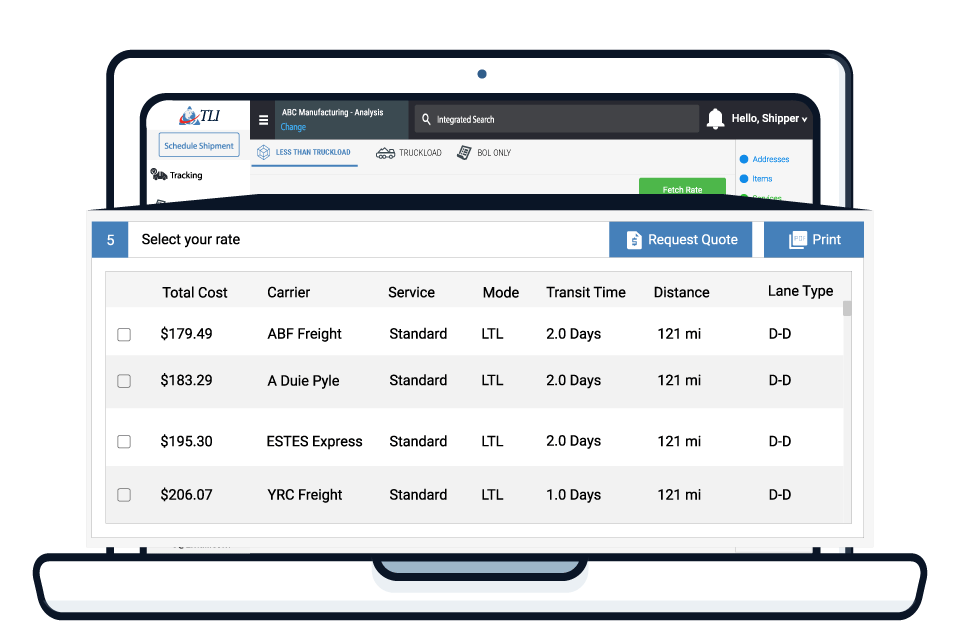
Discount Freight
Discount freight refers to shipping services offered at reduced rates compared to standard pricing. These discounts are typically applied to a carrier's base tariff rates, which are the published prices for transporting goods. Carriers provide discounts to attract and retain customers, fill capacity, or compete in specific markets.
Discounts on tariffs work by applying a percentage reduction to the base rate. For example, a carrier might offer a 70% discount on their published tariff. If the base rate for a shipment is $1000, the discounted price would be $300. These discounts vary based on factors like shipping volume, lane, freight class, and the relationship between the shipper and carrier. Larger shippers often negotiate deeper discounts due to their higher volume. Carriers may also offer different discount levels for various services or lanes to incentivize specific types of shipments. It's important to note that while discount freight can significantly reduce shipping costs, the final price still depends on other factors such as accessorials, fuel surcharges, and minimum charges. Shippers must carefully analyze these elements alongside the discount to determine the true cost-effectiveness of a carrier's offer.
The concept of discount freight, while appealing on the surface, can often be misleading for shippers without access to advanced technology or market insights. Many carriers advertise substantial discounts off their base tariffs, creating the illusion of significant savings. However, these discounts are applied to inflated base rates, making it difficult for shippers to gauge the true competitiveness of the offered rates.
This lack of transparency becomes a gimmick because most shippers don't have sophisticated rating engines or dynamic routing guides to effectively compare rates across multiple carriers. Without these tools, shippers struggle to see through the discount smoke screen and determine the actual all-in costs. This is where freight brokers like TLI (Translogistics Inc.) play a crucial role. By partnering with brokers equipped with Transportation Management Systems (TMS), shippers gain access to true rate comparisons. TLI's TMS provides real-time, all-in rate calculations, factoring in base rates, discounts, accessorials, and current market conditions. This technology enables shippers to make informed decisions based on accurate, comprehensive data rather than relying on potentially misleading discount percentages. By leveraging a 3PL broker's advanced tools and market expertise, shippers can cut through the gimmick of discount freight and secure genuinely competitive rates that align with their specific shipping needs and budget constraints.
Domestic Freight
Domestic freight refers to shipments within the continental United States.
Drayage
Drayage refers to the short-distance transportation of freight, typically involving the movement of shipping containers between ports, rail yards, and nearby warehouses or distribution centers. This critical component of intermodal logistics bridges the gap between long-haul transportation and local delivery. Drayage providers use specialized trucks to transport containers over short distances, facilitating the transfer of goods between different modes of transportation and ensuring the smooth flow of cargo through supply chains.
For international containers, drayage plays a vital role in the import and export process. When ocean vessels arrive at ports, drayage companies quickly move containers from the ship to inland facilities for customs clearance, unpacking, or further transportation. Similarly, for exports, drayage services transport loaded containers from warehouses to ports, where they await loading onto ships. This efficient movement of international containers through drayage operations reduces port congestion, minimizes storage fees, and accelerates the overall shipping process. By seamlessly connecting ocean, rail, and truck transportation, drayage ensures that international shipments move swiftly and efficiently from global origins to final destinations, supporting your supply chain.
Drop Deck
Drop deck trailers, also known as step deck or lowboy trailers, feature a lower deck height compared to standard flatbed trailers. The trailer's design includes a drop in the deck behind the gooseneck, creating two distinct levels. This lower deck sits closer to the ground, typically 28-32 inches high, while the upper deck remains at the height of a standard flatbed.
Shippers benefit from drop deck trailers in several key applications. The lower deck height allows for taller cargo that exceeds legal height limits on standard flatbeds. This makes drop decks ideal for transporting oversized equipment, machinery, or prefabricated structures. Construction companies use them to move excavators, bulldozers, and cranes. Manufacturers ship large industrial components or generators. Agricultural businesses transport combines and tractors. The lower center of gravity also improves stability for top-heavy loads. Additionally, the reduced deck height simplifies loading and unloading, especially in areas with overhead restrictions. Drop deck trailers provide versatility for shippers dealing with tall, heavy, or awkwardly shaped freight, offering a solution that combines the accessibility of a flatbed trailer with the ability to accommodate oversized cargo safely and legally.
Drop Shipping
Drop shipping involves shipping goods directly from the shippers vendor to the customer on behalf of the consignor.

Dry Van
Dry van trailers are enclosed, box-like trailers used extensively in the trucking industry. They protect cargo from weather and theft, making them the most popular choice for shippers transporting non-perishable goods. These versatile trailers accommodate a wide range of products, from packaged consumer goods to industrial materials, offering flexibility and security for diverse shipping needs.
The two most common sizes of dry van trailers are 48 feet and 53 feet in length. The 48-foot trailers, while still in use, are gradually being phased out in favor of the larger 53-foot models. These longer trailers maximize cargo capacity, allowing shippers to transport more goods per trip and reduce overall transportation costs. Dry vans typically feature either rollup doors or swing doors (also known as barn doors).
Rollup doors, which slide up into the trailer's roof, provide a 96-inch opening, facilitating easy loading in tight spaces. Swing doors, consisting of two doors that open outward, offer a wider opening of 99-100 inches. This extra width allows for the loading of larger pallets or oversized items. The choice between rollup and swing doors depends on the shipper's specific loading requirements, facility constraints, and the nature of the cargo being transported.
eBay Freight Shipping
eBay freight shipping refers to the transportation of large, heavy, or bulky items sold on the eBay platform. This service caters to sellers dealing with items that exceed standard parcel shipping dimensions or weight limits, requiring freight carriers for delivery.
For large businesses consistently routing freight through eBay, TLI (Translogistics Inc.) offers a streamlined onboarding process. Once onboarded, TLI generates bills of lading and assigns PRO numbers for each shipment, which sellers can link to their eBay orders. This integration simplifies the shipping process and provides better tracking and management of freight shipments.
However, TLI focuses on B2B and B2C clients with regular shipping needs. For one-off orders or infrequent shippers, TLI does not offer direct partnership services. Sellers shipping to residential addresses should be aware of the additional costs involved, particularly the residential delivery fee, which significantly increases the overall shipping expense. While TLI provides access to numerous carrier options, including economy choices for cost-sensitive shipments, these budget-friendly alternatives often come with slower transit times. This trade-off between cost and speed allows eBay sellers to balance their shipping expenses with customer delivery expectations, especially for large or heavy items that require freight shipping services.
**Please be advised, TLI works with small businesses to large publicly traded multi-nationals, but we do not work with one-off shippers.**
Engine Shipping
TLI partners with shippers in the auto industry to streamline the transportation of automotive parts, including engines and transmissions. We understand the unique challenges and requirements associated with these shipments, particularly the strict regulations surrounding the transport of auto parts.
When shipping engines or transmissions, TLI emphasizes the critical requirement that all liquids must be completely removed. This includes oil, coolant, and any other fluids. Carriers willing to transport these components are limited and selective due to the potential risks and cleanup costs associated with fluid leaks. TLI works closely with shippers to ensure compliance, providing guidance on proper draining and packaging procedures. We leverage our extensive network to identify and book carriers experienced in handling automotive parts. These specialized carriers often require additional documentation confirming the dry state of the shipment. TLI manages this process, coordinating between shippers and carriers to meet all requirements. Our team also advises on best practices for securing and protecting these valuable components during transit, minimizing the risk of damage and ensuring a smooth shipping process from pickup to delivery.
Equipment Shipping
Equipment shipping involves transporting heavy machinery such as pinball machines, arcade games, CNC milling machines, and MRI machines. These items are often large, valuable, and sensitive to damage, making proper preparation and protection essential for a safe and secure journey.
When shipping heavy machinery, shippers should take several steps to ensure their equipment arrives in perfect condition. First, crating the equipment is crucial. A well-constructed crate made of sturdy wood will provide a robust barrier against impacts and environmental elements during transit. Custom-built crates can accommodate the specific dimensions and weight of your machinery, offering tailored protection.
In addition to crating, shippers should also band and shrink-wrap their equipment. Banding involves using heavy-duty straps to secure the machinery firmly within the crate, preventing any movement that could cause damage. Shrink-wrapping adds an extra layer of protection by tightly covering the equipment, shielding it from dust, moisture, and other contaminants.
TLI also offers additional insurance products to give shippers peace of mind. Standard freight shipments come with limited liability coverage, which might not fully cover the value of high-end machinery. By purchasing supplemental insurance, you can ensure that the full value of your equipment is protected against potential damage or loss during transit.
By following these best practices—crating, banding, and shrink-wrapping—shippers can significantly reduce the risk of damage to their heavy machinery. Additionally, investing in extra insurance provides an extra layer of security, safeguarding your valuable equipment throughout its journey.
Estate Shipping
When dealing with estate shipping, the first step is to properly pack and crate the items. Many estate sale items are unique and fragile, such as antique furniture, artwork, heirlooms, and collectibles. Customized packing solutions, including the use of bubble wrap, packing peanuts, and sturdy boxes, help protect these items. For larger and more delicate pieces, custom-built crates provide an additional layer of security, ensuring that items are immobilized and cushioned against impacts during transit.
Estate shipping often involves specialized handling to accommodate the diverse range of items. TLI’s experienced professionals understand how to handle delicate antiques, large furniture, and other valuable items with care. They use the appropriate equipment and techniques to safely load and unload items, minimizing the risk of damage.
Expedited Freight
Expedited freight services ensure fast, time-sensitive deliveries. These services can include air shipping, sprinter vans, and cargo vans. Expedited options also extend to team truckload (FTL) loads, where two drivers work together to exceed hours-of-service (HOS) regulations. Additionally, some carriers offer LTL guaranteed services for expedited deliveries.

Fast Freight Services
For larger loads, team truckload (FTL) services use two drivers to continuously transport freight, bypassing hours-of-service (HOS) limitations. Additionally, some carriers provide LTL guaranteed services, ensuring that even smaller shipments meet strict delivery deadlines.
Similarly, fast freight services prioritize timely delivery, understanding that meeting delivery windows can be as crucial as managing costs. While cost efficiency remains important, the primary focus is on ensuring that shipments arrive on schedule. Both expedited and fast freight services cater to businesses that require rapid, reliable delivery solutions, reflecting the industry's commitment to balancing speed and cost.
Final Mile
Final mile delivery is the last leg of the shipping process where goods are transported from a distribution hub or fulfillment center to the end destination, typically a residence or business. This service includes inside delivery, unpacking, and in some cases, assembly and installation. Final mile logistics are crucial for ensuring customer satisfaction and meeting delivery expectations, especially for bulky items or products requiring specialized handling. Efficient final mile logistics are essential for e-commerce and retail businesses striving to provide excellent customer service and streamline the shipping experience from start to finish.
First Mile
First mile services include inside pickup from the origin and packaging.
Free on Board (FOB)
FOB determines when ownership and responsibility for goods transfer from the seller to the buyer.
Freeze Protection
Protect from freeze services safeguard goods from exposure to extremely cold temperatures during transit. This service is crucial for preventing damage to sensitive items that could be compromised by freezing conditions. By utilizing specialized equipment and climate-controlled facilities, carriers ensure that goods remain at stable temperatures throughout their journey. This is particularly important for products such as chemicals and certain plastic resins, which can become unusable or hazardous if exposed to freezing temperatures.
In cases where goods require protect from freeze services, LTL (Less than Truckload) carriers may opt to store freight inside their terminals rather than in trailers. This practice allows carriers to maintain a controlled environment that protects sensitive cargo from temperature extremes. By storing goods indoors, carriers can add extra layers of protection against adverse weather conditions, ensuring the integrity of the shipment until it reaches its destination. This approach is favored for shipments of chemicals and specific plastic resins, where maintaining consistent temperatures is critical to preserving product quality and safety.
Freight
Freight encompasses shipments that are boxed, crated, or palletized and exceed 150 pounds in weight or have dimensions equal to or greater than 4 feet in length. Alternatively, freight can occupy 2 feet or more of trailer space. Freight can vary in size and shape, from large boxes to pallets loaded onto trucks for transportation.
Carriers have different definitions and classifications for freight, but generally speaking, if the shipment weighs less than 150 pounds, it typically falls under minimum Less than Truckload (LTL) charges.
Freight Agency
A freight agency acts as a liaison between customers and freight carriers.
Freight Agents
A freight agent is a licensed broker authorized to conduct business on behalf of another company, facilitating the transportation of goods by negotiating contracts with carriers. They act as intermediaries between shippers and carriers, ensuring efficient logistics management and overseeing the movement of freight from origin to destination.
Freight Bill Audit
Freight bill audits involve the thorough examination of shipping invoices to verify accuracy and ensure adherence to agreed-upon rates and terms between shippers and carriers. These audits aim to identify any discrepancies, such as incorrect charges or billing errors, and reconcile them accordingly. By conducting freight bill audits, companies can manage shipping costs effectively, maintain transparency in financial transactions, and optimize their logistics operations.
Freight Broker
A freight broker is a crucial intermediary in the logistics industry, connecting shippers with carriers to facilitate the transportation of goods. Acting as a liaison, they negotiate competitive rates, coordinate shipments, and ensure smooth logistics operations from pickup to delivery. TLI stands out as a leading freight broker, renowned for its exceptional customer service, extensive network of reliable carriers, and commitment to delivering cost-effective and efficient shipping solutions. With TLI, shippers benefit from tailored logistics strategies, tracking capabilities, and personalized client support, making them the preferred choice for businesses seeking reliable freight brokerage services.
Freight Carrier
A freight carrier, often referred to as a motor carrier, common carrier or trucking carrier, is responsible for transporting goods from one location to another. These carriers play a vital role in logistics by providing transportation services via trucks, ensuring that shipments are delivered safely and on time. They adhere to established routes and schedules, offering reliability and efficiency in freight transportation.
Freight Center
A freight center serves as a designated hub for organizing and managing shipping activities. It is a pivotal location where logistics operations such as loading, unloading, and sorting of freight take place. Freight centers are strategically positioned to facilitate efficient movement of goods, ensuring shipments are processed swiftly and dispatched to their destinations effectively.
Freight Class
Freight class is a standardized classification system used in the shipping industry to categorize different types of freight based on their characteristics. This classification helps determine shipping rates, as freight classes are associated with specific pricing tariffs set by carriers. The freight class is primarily determined by two factors: the density of the shipment and its stowability, handling, and liability characteristics.
Density plays a crucial role in assigning freight class because it indicates how much space a shipment occupies relative to its weight. Density is calculated in pounds per cubic foot (PCF), which is obtained by dividing the weight of the shipment by its volume. Higher density shipments typically have lower freight classes, meaning they are less costly to ship per pound compared to lower density shipments.
To accurately determine the freight class, shippers often use a density calculator to calculate the PCF of their shipments. This calculation helps ensure that the freight class assigned aligns with the density of the goods, thereby optimizing shipping costs and compliance with carrier regulations.
Translogistics International (TLI) enhances this process through its Transportation Management System (TMS), which includes automated tools to determine freight class. TLI's TMS integrates density calculation functionalities, allowing for precise and efficient classification of shipments based on their density and other relevant factors. This automation not only streamlines the shipping process but also helps TLI and its clients make informed decisions regarding shipping strategies and cost management.
Freight Companies
Freight companies transport goods on behalf of customers.
Freight Consolidation
Freight consolidation is a cost-saving practice that involves combining multiple smaller shipments into a single larger shipment. By consolidating freight, companies can optimize truck space and reduce transportation expenses. This process is particularly beneficial for shippers with smaller volumes of goods or those who frequently ship less-than-truckload (LTL) shipments.
Translogistics (TLI) excels in freight consolidation by offering flexible options tailored to meet diverse shipping needs. TLI can build partial truckloads (PTL), where multiple shipments from different shippers are combined to fill a truck efficiently. This method maximizes truck capacity utilization and reduces per-unit shipping costs.
Additionally, TLI specializes in multistop truckloads, arranging deliveries to multiple destinations within a single truckload shipment. This approach enhances efficiency by minimizing transit times and optimizing route planning, benefiting customers with varied delivery requirements across geographic regions.
Furthermore, TLI provides inbound freight consolidation services, consolidating raw materials and components from various suppliers into cohesive shipments for customers. By streamlining inbound logistics, TLI helps businesses enhance inventory management, reduce handling costs, and improve supply chain efficiency. These capabilities underscore TLI's commitment to cost-effective and efficient freight management solutions tailored to meet the specific needs of its clients.
Freight Cost
Freight cost refers to the total expense incurred for transporting goods from one location to another. It comprises three primary components that collectively determine the final shipping charge:
- Line Haul: This component accounts for the base transportation cost and is influenced by the distance between the origin and destination zip codes. Carriers establish tariffs based on specific zip code pairs, reflecting the mileage and operational costs associated with transporting freight along designated routes.
- Fuel Surcharge: As a variable component, the fuel surcharge fluctuates in response to changes in fuel prices. Carriers apply this surcharge to offset fuel-related expenses incurred during transportation. It is typically calculated as a percentage of the base line haul cost and adjusted periodically based on prevailing fuel prices.
- Accessorials: These are additional services or charges beyond standard freight transportation. Accessorials can include services such as inside delivery, liftgate service, residential delivery, and storage fees. The cost of accessorials varies depending on the specific service provided and is added to the base shipping rate.
The determination of line haul pricing is influenced by factors such as freight class and the National Motor Freight Classification (NMFC) number assigned to the shipment. Freight class categorizes goods based on density, handling requirements, and liability, impacting the tariff rate assigned to each shipment. Similarly, the NMFC number provides a standardized classification for freight, guiding carriers in determining appropriate handling and pricing structures.
Translogistics (TLI) utilizes advanced Transportation Management Systems (TMS) to accurately calculate and optimize freight costs. By leveraging these systems, TLI effectively manages line haul pricing, fuel surcharges, and accessorials, ensuring competitive shipping rates and efficient logistics operations tailored to meet customer needs. This comprehensive approach underscores TLI's commitment to delivering cost-effective and reliable freight transportation solutions.
Freight Forwarder
A freight forwarder is a logistics specialist who arranges and manages the transportation of goods on behalf of shippers. They play a crucial role in optimizing supply chains by coordinating FCL (Full Container Load) and LCL (Less than Container Load) shipments. Freight forwarders negotiate with carriers, handle documentation, and ensure efficient routing of shipments from origin to destination. For FCL shipments, freight forwarders book entire containers for one shipper, maximizing space and minimizing costs per unit. In contrast, for LCL shipments, they consolidate multiple shippers' goods into a shared container, reducing expenses for smaller shipments.
Freight Forwarding
Freight forwarding involves third parties organizing shipments without transporting the freight with their own transport assets.
Freight Hauler
A freight hauler, often synonymous with a motor carrier, is a company or individual responsible for transporting goods via trucks over land. They play a pivotal role in the logistics industry by physically moving freight from one location to another, ensuring timely delivery and efficient supply chain operations. Most commonly, a freight hauler operates trucks of various sizes and capacities to accommodate different types of cargo, ranging from small parcels to large shipments requiring specialized handling. These carriers adhere to strict safety and regulatory standards while navigating road networks to deliver goods across local, regional, and national distances. As motor carriers, freight haulers are essential components of the transportation infrastructure, facilitating the movement of goods crucial for commerce and trade.
Freight Hauling
Freight hauling typically involves goods over 100 lbs or larger than 4 feet.
Freight Insurance
Freight insurance serves as essential liability coverage during the transit of goods, protecting against potential loss or damage. The scope of cargo liability can be customized to suit specific contractual agreements, with terms negotiated between parties involved. Each carrier's tariff structure is distinct, often offering varying tiers of coverage where higher levels of insurance correlate with increased line haul charges.
These additional services ensure that shipments are fully covered, offering peace of mind to clients concerned about potential risks during transportation. TLI's approach underscores their commitment to delivering secure and reliable freight logistics solutions tailored to meet individual customer needs.
Freight Liability
Freight liability refers to the carrier's responsibility and legal obligation for the goods they transport. It encompasses the carrier's liability for any loss, damage, or delay that occurs during transit. This liability is typically governed by terms outlined in the carrier's bill of lading or transportation contract. Freight liability coverage varies among carriers and can be influenced by factors such as the type of goods being shipped, their value, and the agreed-upon terms between the shipper and carrier. Understanding freight liability is crucial for both shippers and carriers to ensure clarity and protection in the event of any unforeseen incidents during shipment.
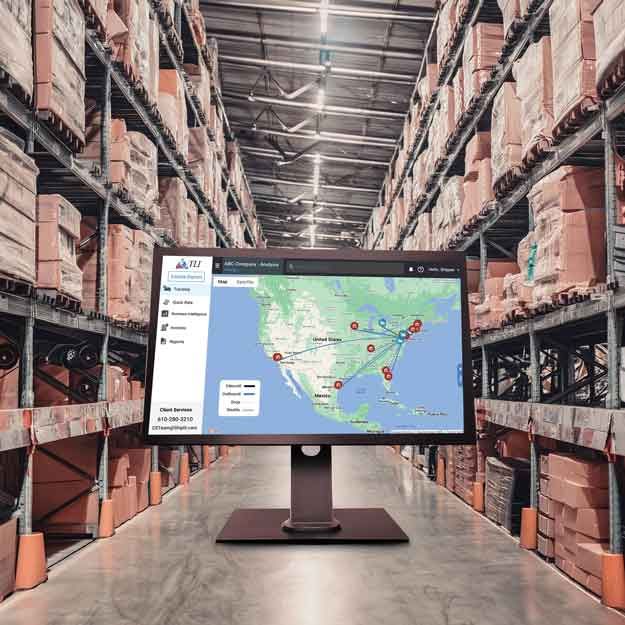
Freight Lines
Freight lines refer to transportation companies.
Freight Load
A freight load is another term for a shipment or cargo.
Freight Logistics Companies
Logistics companies help shippers streamline their supply chain by transporting goods.
Freight Matching
Freight matching involves the process of pairing shippers' freight with suitable carriers to optimize transportation efficiency and cost-effectiveness. Translogistics Inc (TLI) enhances this process through its Transportation Management System (TMS), which intelligently matches shippers' specific freight requirements with carriers' capabilities. TLI's TMS utilizes advanced algorithms to identify the least cost provider carriers, and modes of transportation, ensuring timely and reliable delivery of goods. Additionally, TLI utilizes load boards such as DAT (Dial-A-Truck) to further expand carrier options and enhance freight matching capabilities. This comprehensive approach enables TLI to provide shippers with tailored logistics solutions that maximize efficiency and minimize costs throughout the shipping process.
Freight Quote
A freight quote estimates the cost of shipping goods before pickup.
Freight Rates
Freight rates are the base tariff or contract rate charged by a carrier.
Freight Rate Calculator
Inside Translogistics' Transportation Management System (TMS), there is a sophisticated freight rate calculator designed to streamline the logistics process. This tool automates the retrieval of shipping rates based on various factors such as shipment size, weight, origin, destination, and carrier preferences.
By integrating real-time data and carrier-specific tariffs, the freight rate calculator provides accurate and up-to-date pricing information instantly. This feature allows TLI to efficiently compare rates across multiple carriers, optimize cost-saving opportunities, and expedite decision-making for shippers. Ultimately, the TMS's freight rate calculator enhances transparency, efficiency, and cost-effectiveness in managing logistics operations for TLI and its clients.
Freight Services
Freight services involve transporting goods by various modes such as LTL, TL, rail, intermodal, cargo container, and air freight.
Freight Shipping
Freight shipping transports goods over 150 lbs or larger than 4 feet.
Freight Shipping Calculator
A freight shipping calculator on eCommerce sites helps customers calculate shipping charges.
Freight Shipping Cost
Freight shipping cost typically comprises three main components that collectively determine the total expense of transporting goods. First, the line haul refers to the base transportation cost, calculated based on factors such as distance traveled and the specific route taken. Second, a fuel surcharge is applied to account for fluctuations in fuel prices, ensuring carriers can cover the costs associated with fuel consumption during transit. Finally, accessorials are additional services or charges beyond standard freight transportation, which may include services like inside delivery, liftgate use, or storage fees. These accessorials vary depending on specific shipment requirements and are added to the base shipping rate to provide a comprehensive view of the overall freight shipping cost. Understanding these components helps shippers and carriers effectively manage logistics expenses and optimize shipping operations.
Freight Shipping Quotes
Freight shipping quotes provide estimated costs for shipping freight, offering shippers an initial understanding of expenses before committing to transportation services. Translogistics Inc (TLI) stands out as a leading freight broker, renowned for providing accurate and competitive freight shipping quotes. Leveraging their extensive network of carriers and advanced Transportation Management System (TMS), TLI ensures precise rate calculations based on factors like shipment size, weight, origin, and destination. This enables shippers to make informed decisions and optimize cost-efficiency in their logistics operations. TLI's commitment to reliability and customer satisfaction makes them a preferred choice for obtaining reliable freight shipping quotes tailored to meet diverse shipping needs.
Freight Shipping Rates
The cost of shipping goods via freight service.
Freight Shipping Services
Freight shipping services encompass a range of activities designed to facilitate the efficient and secure transportation of goods from one location to another. This includes freight routing, which involves planning the optimal routes and modes of transport for shipments to reach their destinations in a timely manner while minimizing costs and maximizing efficiency. Carrier load tendering is the process of assigning shipments to carriers based on their capabilities and availability, ensuring that freight is picked up and delivered according to schedule.
Freight invoice audit involves reviewing and verifying carrier invoices to ensure accuracy and identify any discrepancies or errors in billing. Lastly, freight claims management is responsible for handling and resolving claims for lost, damaged, or delayed shipments, ensuring that shippers receive compensation or replacement for their goods as per agreed-upon terms. These comprehensive freight shipping services provided by companies like Translogistics Inc (TLI) streamline logistics operations, enhance transparency, and mitigate risks associated with transporting goods.
Freight Terminal
A freight terminal prepares incoming freight for reloading into another transport mode.
Freight Transportation
Freight transportation refers to the movement of goods and cargo from one location to another using various modes of transportation such as trucks, trains, ships, or airplanes. It plays a crucial role in supply chain logistics, enabling businesses to deliver products to customers, suppliers, or distribution centers efficiently and reliably. Freight transportation involves the coordination of routes, scheduling, and logistics management to ensure that goods are transported safely and on time. This process includes activities such as loading, unloading, tracking shipments, and adhering to regulatory requirements governing the transportation of goods. Overall, freight transportation forms the backbone of global trade and commerce, facilitating economic activity by connecting producers with consumers across local, regional, and international markets.
Freightways
Freightways refer to transportation companies.
Government Shipping
Government shipping services cater to both military and non-military agencies.
Government Shipping Companies
Government Shipping Companies are freight brokers that provide shippers delivery services to government facilities such as military bases.
Ground Freight
Ground freight involves transporting parcel goods by truck over roads.
Groupage Shipping
Groupage shipping consolidates goods from various companies into a single shipment.
Handling Unit
A handling unit is a distinct piece of packaged freight moved by a forklift, pallet jack, or by hand.
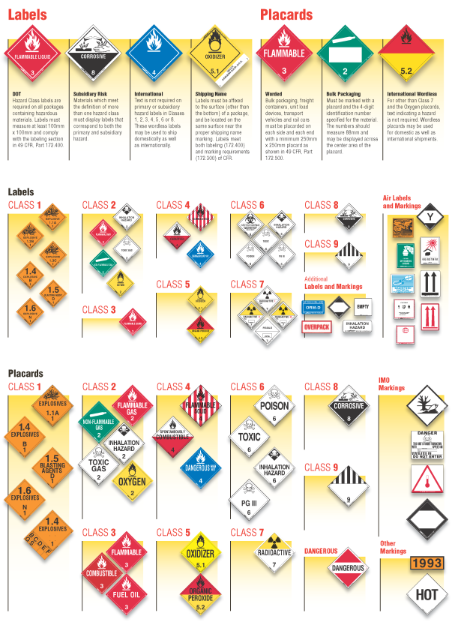
Hazmat
Hazmat freight, short for hazardous materials freight, refers to goods that present potential risks to health, safety, property, or the environment during transportation. These materials require special handling, packaging, labeling, and documentation to ensure safe transport and compliance with regulatory standards. Hazmat freight includes a wide range of substances such as chemicals, gases, flammable liquids, explosives, radioactive materials, and infectious substances.
To facilitate safe handling and transportation, hazmat shipments are assigned custom reference codes like UN numbers (United Nations numbers). These codes classify the specific hazards and properties of the materials being transported, aiding carriers, emergency responders, and regulatory authorities in identifying and managing the risks associated with hazmat freight effectively.
Heavy Freight
Heavy freight exceeds 8,000 lbs and occupies a truck’s space and weight limits.
Inside Delivery & Pickup
Inside delivery and pickup go beyond standard curb-to-curb or dock-to-dock services.
International Freight Shipping
International freight refers to the transportation of goods and cargo between countries or across borders. It involves utilizing various modes of transport such as ships, airplanes, trucks, or trains to move goods from their origin to their destination overseas. International freight can be categorized into two main types:
- Less than Container Load (LCL): In LCL shipping, multiple shippers' goods are consolidated into a single container. Each shipper pays for space proportional to the volume of their cargo. LCL is cost-effective for smaller shipments that do not fill a full container.
- Full Container Load (FCL): FCL shipping involves a single shipper renting an entire container to transport their goods. This option is suitable for larger shipments that require exclusive use of a container.
In international freight logistics, several key concepts are essential:
- Exporting: Exporting involves sending goods produced in one country to another country for sale or distribution. Exporters must comply with export regulations, documentation requirements, and customs procedures of both the exporting and importing countries.
- Importing: Importing involves the process of bringing goods and products into one country from another for purposes of distribution, sale, or use. It encompasses several critical steps and considerations, starting with compliance with customs regulations of the importing nation. This includes preparing and submitting necessary documentation such as import licenses, invoices, and certificates of origin to facilitate customs clearance. Importers must also calculate and pay applicable tariffs, duties, and taxes based on the classification and value of the imported goods, as outlined in the importing country's tariff schedule. Coordinating transportation and logistics is essential, often involving collaboration with freight forwarders, motor carriers, and logistics providers to ensure smooth movement of goods from the port of entry to their final destination. Importers are responsible for verifying that imported goods meet local quality standards, safety regulations, and any required certifications. Importing operations may also involve cross trading or drop shipping arrangements, where goods are shipped directly from suppliers in third countries to customers without passing through the importer's home country. Successful importing requires comprehensive knowledge of international trade laws, logistics management, and proactive compliance with evolving regulations and market conditions.
- Cross Trading (Drop Shipping): Cross trading, also known as drop shipping, occurs when goods are shipped directly from the manufacturer or supplier in one country to a customer in another country without the goods passing through the seller's own country. This process involves managing logistics, documentation, and customs clearance across multiple jurisdictions.
Managing international freight requires expertise in navigating trade regulations, customs clearance procedures, and coordinating with various stakeholders such as freight forwarders, customs brokers, and carriers. Effective logistics planning ensures smooth and efficient movement of goods across international borders, facilitating global trade and supply chain operations.
Interstate Freight
Interstate freight moves from one state to another, whether a full truckload or less than a truckload.
Interstate Truckers
Interstate truckers transport goods along domestic interstate highways.
Lift Gate
A lift gate is needed if the site lacks a loading dock and the cargo is too heavy for manual handling.
Limited Access
Limited access locations, such as schools or airports, lack clear access for trucks.
Lean Supply Chain
A lean supply chain reduces waste while optimizing efficiency in production and distribution.
Logistics
Logistics involves planning, managing, and controlling the movement, storage, and flow of goods from origin to destination.
LTL
LTL stands for "Less than Truckload."
LTL Trucking
LTL trucking handles shipments larger than parcels but smaller than a full truckload.
Military Freight
Military freight refers to shipments of goods and materials destined for military installations, bases, or operations. These shipments often require specialized handling and compliance with strict security protocols and regulations set by military authorities. TLI (Translogistics Inc.) specializes in managing military freight logistics by providing expertise in navigating the unique requirements of military deliveries. This includes ensuring that drivers possess Transportation Worker Identification Credential (TWIC) cards and are U.S. citizens, as mandated for access to certain military bases and sensitive installations. TLI excels in coordinating deliveries to military bases, nuclear facilities, and other restricted access locations where adherence to security procedures and delivery timelines is crucial. By leveraging their experience and capabilities in military and nuclear logistics, TLI ensures reliable and compliant transportation solutions that meet the specific needs and challenges of military freight operations.
Motor Freight
Motor freight transports goods by motor carrier over highways.
Moving Freight
Moving freight involves transporting goods that exceed standard parcel sizes, typically weighing over 150 pounds or larger than 4 feet in any dimension. Unlike smaller parcels, which are usually handled by package delivery services, moving freight requires specialized transportation methods such as trucks, rail, or air freight depending on the shipment's size, weight, and destination. This category of freight often requires additional handling equipment and may involve different logistics processes to ensure safe and efficient delivery. Moving freight services cater to businesses and individuals needing to transport larger or heavier items, offering tailored solutions to meet specific shipping requirements and ensure goods arrive securely and on time.
Not Otherwise Indicated (NOI)
NOI determines the freight class for goods not classified by the NMFTA.
Oversize Freight
Oversize freight refers to shipments that exceed the standard dimensions typically accommodated by standard trailers. These shipments may include items that are longer, wider, taller, or heavier than what can be transported using conventional transportation methods. Due to their size, oversize freight often requires special permits, escorts, and specialized equipment for safe and legal transport. Carriers specializing in oversize freight must adhere to strict regulations governing dimensions, weight limits, and route planning to ensure the safety of both the shipment and other road users. Handling oversize freight requires expertise in logistics and coordination to navigate potential logistical challenges and ensure timely delivery to the destination.
Overweight or Heavy Freight
Overweight or heavy freight weighs over 8,000 lbs and occupies a truck’s full capacity.
Parcel Shipping
Parcel shipping involves standard package transportation.
Personal Effects
Personal effects refer to household goods or personal property.
Pounds per Cubic Foot (PCF)
PCF measures the density of freight, crucial for calculating freight class.
Proof of Delivery
Proof of Delivery, or Delivery Receipt, confirms the delivery of goods.

Refrigerated Freight
Refrigerated freight transports goods that need cooling or freezing.
SCAC Codes
SCAC codes uniquely identify transportation companies with two to four letters.
Sea Cargo Container
Sea cargo containers are essential for transporting a wide range of goods across the world's oceans. These containers are standardized units that can be loaded onto ships, stacked in ports, and transported seamlessly between different modes of transportation, including ships, trucks, and trains. Sea cargo containers ensure efficient and secure transportation by protecting goods from the elements and providing a standardized method for handling and tracking shipments throughout their journey. They play a critical role in global trade by facilitating the movement of goods between continents and enabling businesses to access international markets effectively.
Shared Truckload
Shared truckload shipping matches compatible freight to maximize trailer use and reduce costs.
Shippers
Shippers send goods, also known as customers or consignors.
Shipping
Shipping refers to transporting goods over 150 lbs or larger than 4 feet.
Shipping Companies
Shipping companies specialize in the transportation of goods on behalf of customers, offering essential logistics services to move cargo efficiently and securely. These companies manage the entire process from pickup to delivery, utilizing various modes of transportation such as trucks, ships, airplanes, and trains depending on the shipment's requirements and destination. They provide comprehensive solutions that include tracking, handling documentation, and ensuring compliance with shipping regulations and safety standards. By leveraging their expertise and infrastructure, shipping companies facilitate global trade and commerce, enabling businesses to reach markets worldwide with reliable and timely delivery of goods.
Shipping Cost
Shipping cost is the actual expense of transporting goods.
Shipping Furniture
Shipping furniture requires expertise, especially for new shippers.
Shipping Labels
Shipping labels ensure cargo reaches the
Shipping Rates
Shipping rates are the prices charged by freight carriers based on various factors.
Shipping Service
Shipping service involves the transportation of goods and packages weighing more than 150 lbs or larger than 4 feet.

Small Business Shipping
Small business shipping combines advanced technology with expert freight shipping services, allowing small businesses to focus on their core activities.
Supply Chain Logistics
Supply chain logistics plans adapt to changing times to optimize efficiency and reduce waste.
Third-Party Logistics (3PL)
Third-party logistics (3PL) providers offer outsourced freight brokerage and supply chain services.
Tradeshow Shipping
Tradeshow shipping ensures your booth arrives on time, complementing your booth space reservation.

Transportation Brokers
Transportation brokers, also known as freight brokers, arrange the transport of goods through contracts with carriers.
Transportation Companies
Transportation companies, including common carriers and trucking companies, provide freight services.
Trucking
Trucking involves transporting goods over the road (OTR) via trucks.
Trucking Broker
A trucking broker, or freight broker, arranges the transport of goods through contracts with carriers.
Trucking Business
A trucking business is a general motor carrier that provides freight transportation by truck.
Trucking Companies
Trucking companies offer ground, over-the-road (OTR) freight services.
Trucking Cost per Mile
Trucking cost per mile is the expense incurred for each mile that goods are transported by truck.
Trucking Rates
Trucking rates are set based on a national trucking index, which factors in both base tariff or contract rates and spot market rates. These rates fluctuate based on market demand, fuel costs, and other variables influencing transportation costs. The base tariff rates are established by carriers for specific routes and services, while spot market rates vary with current market conditions and immediate freight availability. This dynamic pricing model allows carriers and shippers to adjust their strategies based on real-time market conditions, ensuring competitive pricing and efficient freight transportation solutions.
Trucking Service
Trucking service is the most common way of shipping freight in the USA.
White Glove Service
White glove service involves providing specialized handling and care for shipments, going beyond standard delivery services. It includes inside delivery, where items are brought into the designated room or location within a building. Additionally, it may encompass light installation, such as setting up furniture or appliances. Another aspect is packaging removal, where the service provider unpacks and removes the shipping materials, ensuring a clean and hassle-free delivery experience for the customer. This premium service is ideal for delicate or high-value items requiring extra attention and care during transport and setup.
TLI Insights
Get the latest logistics insights and tips from TLI's award-winning team. Stay ahead in transportation planning.
Questions? Email us at marketing@shiptli.com


